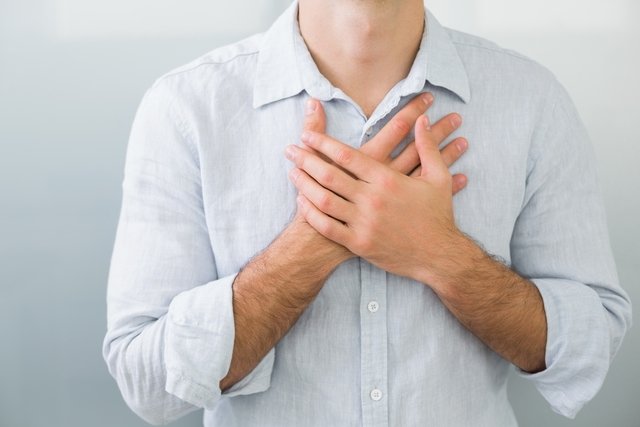In most cases, pain on the right side of the chest is a temporary symptom that appears mainly due to minor situations, such as excess stress, muscle strain or gastroesophageal reflux, for example.
However, chest pain, whether on the right or left side, can have several causes, including problems with the digestive system, lungs and even the heart, which need to be identified and treated.
When pain occurs frequently, it is advisable to consult a cardiologist to identify the cause and initiate appropriate treatment. However, if the pain is very intense, worsens over time or is accompanied by more serious symptoms such as tingling in the arm, difficulty breathing or fainting, it is very important to go to the hospital immediately or call for medical help.
What can chest pain be?
To find out the possible cause of your chest pain, please answer the following questions:
Below we indicate the most common causes of pain on the right side of the chest and what to do in each situation:
1. Stress and anxiety
Excess stress and anxiety are two conditions that can result in a panic attack and cause symptoms very similar to a heart attack, including the appearance of sudden chest pain. This pain is most common in the middle of the chest, but can often end up radiating to the right side.
Along with chest pain, other symptoms such as rapid breathing, feeling short of breath, tingling in the hands or feet and sweating, for example, are common. Unlike a heart attack, a panic attack is more common after a very stressful situation and chest pain tends to improve within a few minutes.
What to do: The best way to alleviate the discomfort caused by a panic attack is to try to calm down, to allow your breathing to become regular and your muscles to become less tense. A good option might be to retire to a calm place and drink a calming tea, such as valerian or chamomile, for example. See other natural calming options. Still, if the pain is very severe or if there is a suspicion that it could be a heart attack, it is important to go to the hospital or call for medical help.
2. Muscle strain
Muscle strain is another of the most common causes of pain in the chest region and occurs 1 to 2 days after some type of activity that uses the muscles in the pectoral region with greater intensity. This increase in intensity on the muscles in the region can be intentional, like training at the gym, but it can also be unintentional, like painting the ceiling or having to cut something hard, for example.
Furthermore, strong blows to the pectoral region can also cause damage to muscle fibers, which may not cause pain immediately, but become sore after a few days. In these cases, other common symptoms are increased pain when touching the muscle, slight swelling and difficulty moving the arms.
What to do: Generally, the pain can be relieved by applying ice to the area for 15 to 20 minutes, 3 to 4 times a day, and a light massage on the area, which can be done with an anti-inflammatory ointment, for example. If the pain does not improve within 3 days, it is advisable to consult a general practitioner or physiotherapist, as more specific treatments may be necessary.
3. Gastroesophageal reflux
Reflux is a common condition that affects many people and occurs when stomach acid rises up into the esophagus, causing a feeling of heartburn and burning, especially after eating. This discomfort can often also be felt in the form of pain that ends up radiating to the chest and can affect the right side.
Gastroesophageal reflux is also usually accompanied by other symptoms such as the urge to burp more frequently, a sour taste in the mouth, a lump in the throat and a dry cough, for example. See other signs and symptoms that help identify reflux.
What to do: Depending on the severity, reflux symptoms can be alleviated with simple dietary changes, such as avoiding eating too much at one time and avoiding eating very fatty and spicy foods. However, in other cases it may also be necessary to use medication to block stomach acid. Therefore, if the discomfort does not improve with dietary changes, it is recommended to consult a gastroenterologist to begin the most appropriate treatment.
4. Costocondrite
Costochondritis is a less common problem but can cause intense pain in the chest region, normally located in the middle of the chest, but which can end up radiating to the right or left side.
This condition happens when the cartilage that connects the sternum bone to the ribs becomes inflamed after strong pressure on the chest, periods of very intense coughing or due to poor posture, for example. Costochondritis causes sensitivity in the middle of the chest and pain that worsens when taking a deep breath or coughing, for example. Learn more about what causes costochondritis and how to identify the symptoms.
What to do: Costochondritis is a temporary problem that tends to improve after a few days, without requiring specific treatment. Still, doing gentle stretching exercises and applying ice to the region for 15 to 20 minutes, 3 to 4 times a day, can reduce inflammation and alleviate discomfort, in addition to the use of anti-inflammatory medications.
5. Inflammation in the gallbladder
The gallbladder is an organ located in the cavity on the upper right side of the abdomen, and can become inflamed if gallstones accumulate inside the organ or if a stone blocks a duct, for example.
When the gallbladder becomes inflamed, it can cause pain in the upper right side of the abdomen that can radiate to the chest or back, and be accompanied by other symptoms such as nausea, vomiting, fever or yellowing of the skin and eyes, generally in the case of acute inflammation, Symptoms usually appear about 1 hour or a little longer after eating fatty foods.
What to do: you should consult a gastroenterologist or hepatologist for an evaluation. If the pain is severe, you should go to the hospital immediately to begin the most appropriate treatment, which generally involves oral hydration or intravenous fluid, use of antibiotics and painkillers, and surgery to remove the stones or gallbladder.
6. Inflammation in the liver
The liver is also an organ located in the upper right side of the abdomen, and can become inflamed due to infections by viruses or parasites, consumption of high doses of paracetamol or excessive or frequent consumption of alcoholic beverages, or due to fatty liver, for example . See other causes of liver inflammation.
Liver inflammation can cause pain in the upper right side of the abdomen, which can radiate to the chest, in addition to other symptoms, such as vomiting, loss of appetite, general malaise and jaundice.
What to do: The treatment of liver inflammation varies according to its cause, and involves stopping the consumption of alcoholic beverages or medications, as well as specifically treating infections, for example. Furthermore, it is also important to have a balanced diet, which includes the consumption of fresh fruits and vegetables.
7. Pneumonia
Pneumonia is an inflammation of the lungs caused by viruses, bacteria or fungi, aspiration of food or liquids or the use of respiratory equipment in conditions that are harmful to health. It is more common in children under 4 years of age and adults over 70 years of age, as tend to have lower immunity.
Symptoms of pneumonia may appear gradually or quickly, especially when the immune system is weakened, with pain in the back or chest on the right or left side, or on both sides, difficulty breathing, fever or cough.
What to do: you should consult a pulmonologist who should evaluate the lungs through auscultation, asking the person to inhale and exhale, while listening to the lungs with a stethoscope, and chest X-ray to visualize the lungs. Thus, the doctor can indicate the most appropriate treatment according to the cause of the pneumonia, and generally involves the use of antibiotics, antivirals, antifungals or analgesics, for example.
8. Pneumothorax
Pneumothorax is air in the pleural space, which is the space between the lungs and the chest wall, which increases pressure in the lung, causing it to collapse.
When this occurs in the right lung, it can cause pain on the right side of the chest, as well as severe difficulty breathing, coughing and pain when breathing.
Pneumothorax is most common after a chest injury, such as a fall or puncture, but it can also arise as a result of pneumonia or asthma, for example.
What to do: You must go to the hospital or emergency room immediately to undergo tests, confirm the diagnosis and begin treatment to remove excess air and relieve pressure in the lungs, which is done by the doctor with an aspiration needle.
9. Pulmonary embolism
Pulmonary embolism is a blood clot that blocks the blood vessels of the lungs, leading to a decrease in the flow of blood and oxygen to the area, and resulting in ischemia of the affected tissues.
This condition can cause right-sided chest pain if the clot is in the right lung, as well as symptoms such as shortness of breath, cough, chest pain, dizziness and excessive sweating.
Pulmonary embolism can arise due to heart problems, cancer, surgery, clotting disorders or COVID-19, for example.
What to do: Pulmonary embolism must be treated as quickly as possible in hospital as it can be life-threatening. Therefore, if symptoms of pulmonary embolism appear, you should go to the nearest hospital or emergency room immediately.
10. Heart problems
When chest pain appears, one of the main concerns is that it could indicate a heart problem, however, these cases are not common. Still, heart problems, especially inflammation of the heart muscle, can indeed be a cause of chest pain, including pain that radiates to the right side.
Typically, heart problems are more common in the elderly, people with other chronic problems or patients who are hospitalized with serious infections, for example. Cardiac pain is usually quite intense and causes the feeling that something is squeezing the heart. In addition, other symptoms may also appear, such as palpitations, coughing, difficulty breathing and fainting, for example. Check out 12 signs that may indicate heart problems.
What to do: If you suspect that the pain may be caused by a heart problem, it is very important to go to the hospital quickly or call for medical help to identify the cause and begin treatment.
When to go to the doctor
Chest pain often goes away after a few minutes and is therefore not a cause for concern. However, consulting a doctor is the only way to identify the correct cause. Therefore, it is recommended to go to the hospital when:
- The pain is very intense or gets worse over time;
- The pain takes more than 15 minutes to improve;
- Other serious symptoms appear, such as difficulty breathing, high fever or fainting.
Furthermore, the elderly and people with chronic problems, especially with the respiratory or cardiac system, should be evaluated by a doctor, as pain may indicate a worsening of the condition, and it may be necessary to adapt the treatment.

Sign up for our newsletter and stay up to date with exclusive news
that can transform your routine!
Warning: Undefined array key "title" in /home/storelat/public_html/wp-content/plugins/link-whisper-premium/templates/frontend/related-posts.php on line 12
Warning: Undefined array key "title_tag" in /home/storelat/public_html/wp-content/plugins/link-whisper-premium/templates/frontend/related-posts.php on line 13




